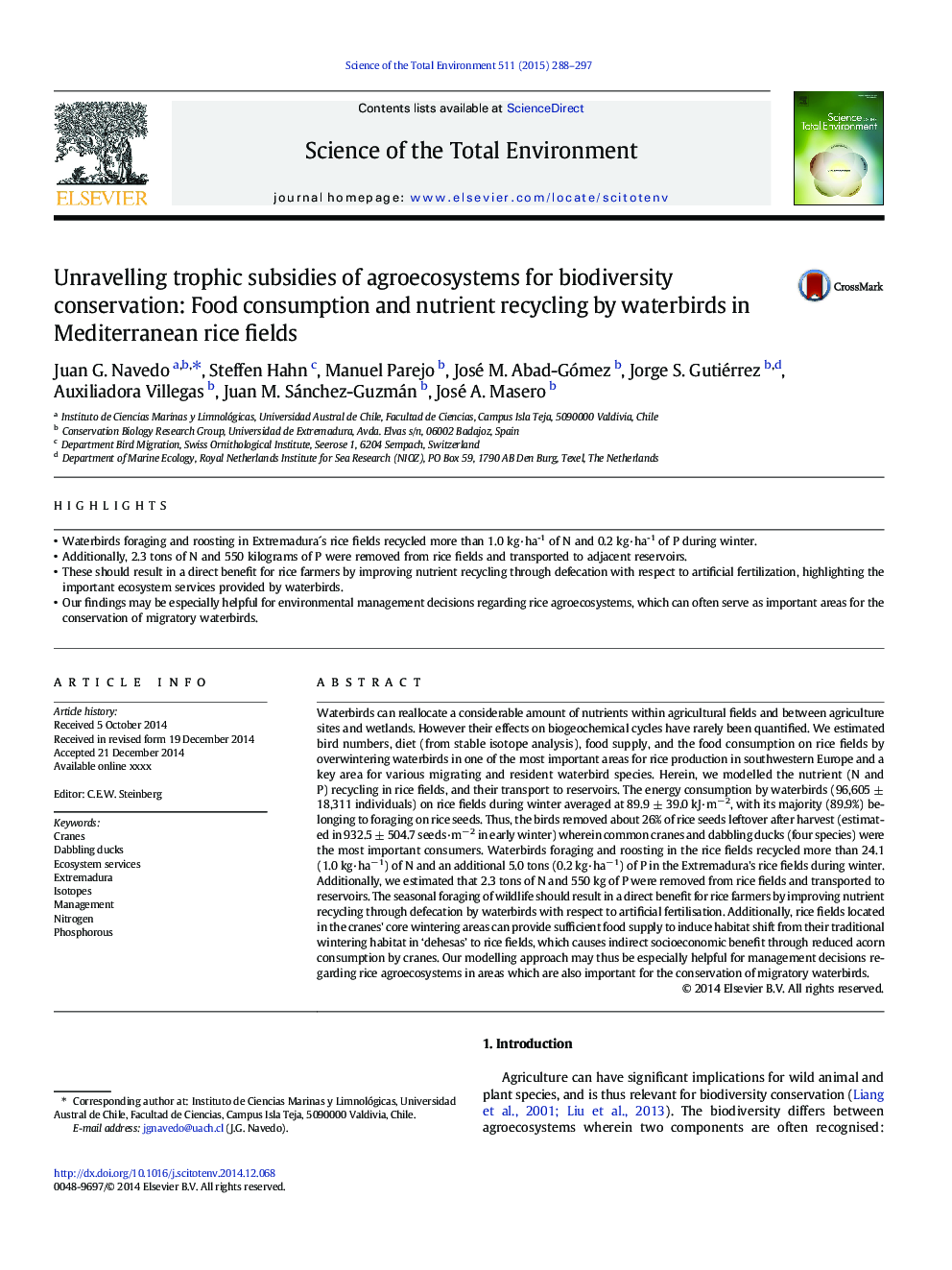| کد مقاله | کد نشریه | سال انتشار | مقاله انگلیسی | نسخه تمام متن |
|---|---|---|---|---|
| 6327459 | 1619766 | 2015 | 10 صفحه PDF | دانلود رایگان |
عنوان انگلیسی مقاله ISI
Unravelling trophic subsidies of agroecosystems for biodiversity conservation: Food consumption and nutrient recycling by waterbirds in Mediterranean rice fields
ترجمه فارسی عنوان
توزیع یارانه های طوفان کشاورزی برای حفاظت از تنوع زیستی: مصرف مواد غذایی و بازیافت مواد مغذی توسط پرندگان آبزی در مزارع برنج مدیترانه
دانلود مقاله + سفارش ترجمه
دانلود مقاله ISI انگلیسی
رایگان برای ایرانیان
کلمات کلیدی
جرثقیل، اردکهای نابالغ، خدمات محیط زیستی، اکسترادورا، ایزوتوپها، مدیریت، نیتروژن، فسفر،
موضوعات مرتبط
علوم زیستی و بیوفناوری
علوم محیط زیست
شیمی زیست محیطی
چکیده انگلیسی
Waterbirds can reallocate a considerable amount of nutrients within agricultural fields and between agriculture sites and wetlands. However their effects on biogeochemical cycles have rarely been quantified. We estimated bird numbers, diet (from stable isotope analysis), food supply, and the food consumption on rice fields by overwintering waterbirds in one of the most important areas for rice production in southwestern Europe and a key area for various migrating and resident waterbird species. Herein, we modelled the nutrient (N and P) recycling in rice fields, and their transport to reservoirs. The energy consumption by waterbirds (96,605 ± 18,311 individuals) on rice fields during winter averaged at 89.9 ± 39.0 kJ·mâ 2, with its majority (89.9%) belonging to foraging on rice seeds. Thus, the birds removed about 26% of rice seeds leftover after harvest (estimated in 932.5 ± 504.7 seeds·mâ 2 in early winter) wherein common cranes and dabbling ducks (four species) were the most important consumers. Waterbirds foraging and roosting in the rice fields recycled more than 24.1 (1.0 kg·haâ 1) of N and an additional 5.0 tons (0.2 kg·haâ 1) of P in the Extremadura's rice fields during winter. Additionally, we estimated that 2.3 tons of N and 550 kg of P were removed from rice fields and transported to reservoirs. The seasonal foraging of wildlife should result in a direct benefit for rice farmers by improving nutrient recycling through defecation by waterbirds with respect to artificial fertilisation. Additionally, rice fields located in the cranes' core wintering areas can provide sufficient food supply to induce habitat shift from their traditional wintering habitat in 'dehesas' to rice fields, which causes indirect socioeconomic benefit through reduced acorn consumption by cranes. Our modelling approach may thus be especially helpful for management decisions regarding rice agroecosystems in areas which are also important for the conservation of migratory waterbirds.
ناشر
Database: Elsevier - ScienceDirect (ساینس دایرکت)
Journal: Science of The Total Environment - Volume 511, 1 April 2015, Pages 288-297
Journal: Science of The Total Environment - Volume 511, 1 April 2015, Pages 288-297
نویسندگان
Juan G. Navedo, Steffen Hahn, Manuel Parejo, José M. Abad-Gómez, Jorge S. Gutiérrez, Auxiliadora Villegas, Juan M. Sánchez-Guzmán, José A. Masero,
